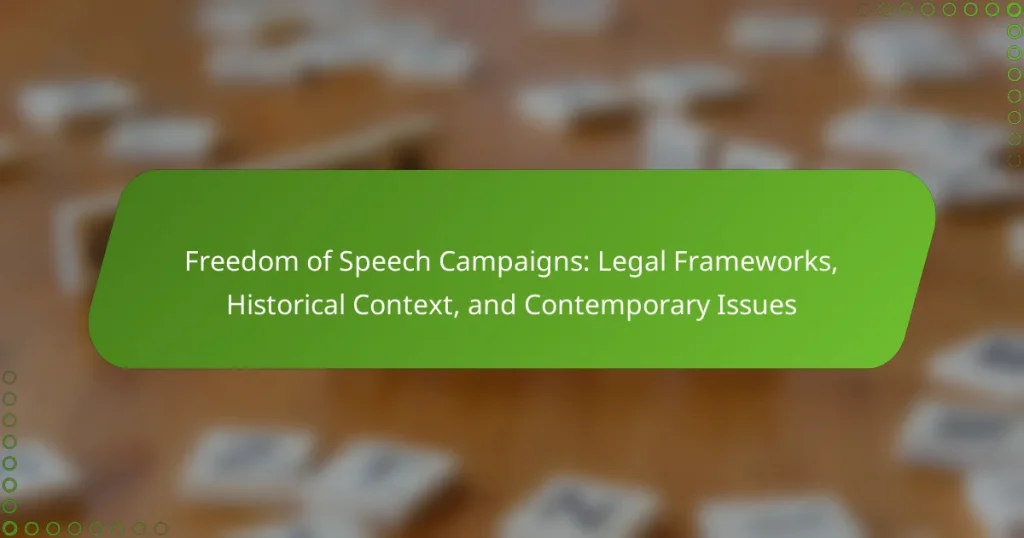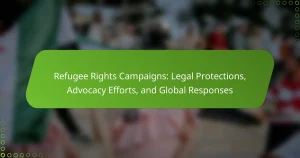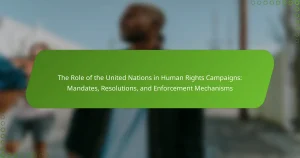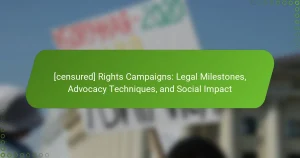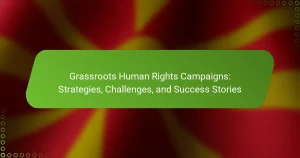Freedom of Speech Campaigns are organized initiatives focused on promoting and safeguarding the right to express opinions without censorship. This article examines the legal frameworks surrounding these campaigns, their historical context from ancient civilizations to modern movements, and the contemporary challenges they face, including misinformation, censorship, and hate speech regulations. It highlights key organizations like the American Civil Liberties Union (ACLU) and Amnesty International that advocate for free speech, as well as landmark legal cases that have shaped the understanding of this fundamental right. The evolving landscape of free expression is explored, emphasizing its critical role in democratic societies and the ongoing struggle for individual rights.
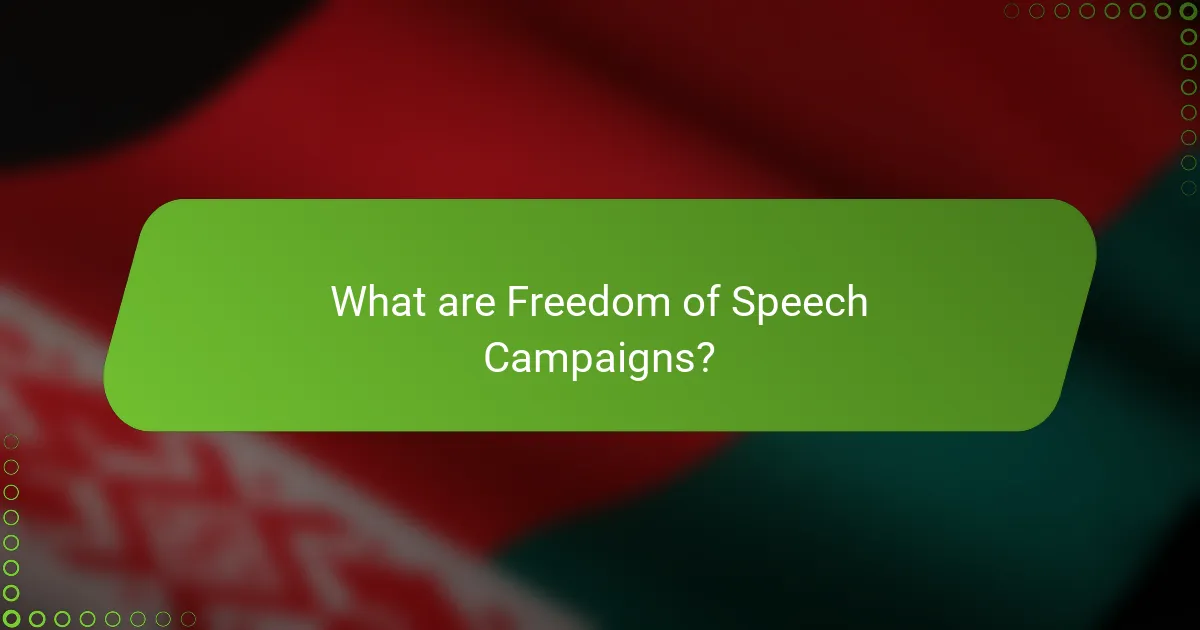
What are Freedom of Speech Campaigns?
Freedom of Speech Campaigns are organized efforts aimed at promoting and protecting the right to express opinions without censorship. These campaigns often advocate for legal reforms to ensure free expression in various contexts, including media, art, and public discourse. They can arise in response to government restrictions, social injustices, or threats to individual rights. Historical examples include movements during the civil rights era and contemporary protests against censorship in authoritarian regimes. Such campaigns often utilize social media, public demonstrations, and legal challenges to raise awareness and influence policy. Organizations like the American Civil Liberties Union (ACLU) and Amnesty International actively support these initiatives. Their efforts highlight the importance of free speech in democratic societies and its role in fostering open dialogue.
How do Freedom of Speech Campaigns influence society?
Freedom of Speech Campaigns significantly influence society by promoting open dialogue and protecting individual rights. They encourage citizens to express their opinions without fear of censorship. This fosters a culture of transparency and accountability in governance. Campaigns often lead to legal reforms that enhance free speech protections. For instance, the First Amendment in the U.S. Constitution was influenced by historical campaigns for free expression. Additionally, these campaigns can mobilize public support for marginalized voices. They raise awareness about issues such as censorship and discrimination. Overall, Freedom of Speech Campaigns shape societal norms around communication and expression.
What historical events sparked the need for Freedom of Speech Campaigns?
The need for Freedom of Speech Campaigns was sparked by events such as the French Revolution and the American Civil War. The French Revolution (1789) emphasized individual rights, including free expression. The American Civil War (1861-1865) highlighted the importance of free speech in a democracy. Additionally, the rise of totalitarian regimes in the 20th century, such as Nazi Germany and Stalinist Russia, further underscored the necessity of protecting free speech. These historical events demonstrated the dangers of censorship and the suppression of dissent. They led to organized movements advocating for the legal recognition of freedom of speech as a fundamental human right.
How do cultural contexts shape Freedom of Speech Campaigns?
Cultural contexts significantly shape Freedom of Speech campaigns by influencing the values and priorities of societies. Different cultures have varied interpretations of what constitutes acceptable speech. For instance, in democratic societies, freedom of speech is often viewed as a fundamental right. In contrast, in authoritarian regimes, speech may be heavily regulated to maintain control.
Cultural norms dictate the boundaries of acceptable discourse. In some cultures, religious sensitivities may restrict speech related to faith. In others, political dissent may be curtailed to promote social harmony. Historical events also play a role; societies with a history of censorship may prioritize freedom of expression more rigorously.
Research indicates that public support for freedom of speech varies across cultures. A Pew Research Center study found that acceptance of free speech correlates with democratic values and education. Campaigns must therefore tailor their messages to resonate with specific cultural attitudes. This ensures that they address local concerns while promoting universal principles of free expression.
What legal frameworks support Freedom of Speech Campaigns?
The legal frameworks that support Freedom of Speech campaigns include national constitutions, international treaties, and statutory laws. National constitutions often enshrine the right to free speech, such as the First Amendment in the United States. International treaties like the Universal Declaration of Human Rights affirm freedom of expression as a fundamental right. Statutory laws, such as the Communications Decency Act in the U.S., regulate speech in specific contexts. These frameworks collectively protect and promote freedom of speech, allowing for diverse expressions in society.
What are the key laws governing freedom of speech in different countries?
Key laws governing freedom of speech vary by country. In the United States, the First Amendment protects free speech from government interference. In the United Kingdom, the Human Rights Act 1998 incorporates the European Convention on Human Rights, which includes freedom of expression. Germany’s Basic Law guarantees freedom of expression while prohibiting hate speech. In Canada, the Canadian Charter of Rights and Freedoms protects freedom of thought, belief, opinion, and expression. Australia lacks a constitutional guarantee but recognizes implied freedom of political communication. Countries like China have strict censorship laws limiting freedom of speech. Each country’s laws reflect its unique historical and cultural context.
How do legal interpretations of freedom of speech vary globally?
Legal interpretations of freedom of speech vary significantly across different countries. In the United States, the First Amendment protects speech broadly, including offensive and hate speech. Conversely, many European countries impose restrictions on hate speech to protect public order and individual dignity. In some authoritarian regimes, such as North Korea and China, freedom of speech is heavily censored, and dissent is punishable. Internationally, treaties like the International Covenant on Civil and Political Rights recognize freedom of expression but allow limitations for national security and public safety. Cultural, historical, and political contexts shape these legal interpretations. For instance, post-colonial societies may prioritize collective rights over individual freedoms.
What are the challenges faced by Freedom of Speech Campaigns today?
Freedom of Speech Campaigns today face significant challenges. These include increasing government censorship and surveillance. Many countries impose restrictions on online expression. Social media platforms often enforce content moderation policies that limit free speech. Activism can lead to backlash, including legal repercussions for campaigners. Misinformation complicates the landscape, as it can undermine legitimate discourse. Additionally, societal polarization can stifle open dialogue. The rise of hate speech laws raises concerns about overreach. These factors collectively hinder the effectiveness of freedom of speech advocacy efforts.
How do social media platforms impact Freedom of Speech Campaigns?
Social media platforms significantly impact Freedom of Speech Campaigns by providing a space for widespread dissemination of ideas. They enable users to share opinions and mobilize support for various causes. This accessibility amplifies voices that may be marginalized in traditional media. However, social media also presents challenges, such as the potential for censorship and misinformation. Algorithms can limit the visibility of certain viewpoints. Additionally, platforms may enforce community guidelines that restrict speech perceived as harmful. Reports indicate that around 59% of users believe social media has a positive effect on free expression. Despite this, the balance between free speech and platform policies remains a contentious issue.
What role do government regulations play in Freedom of Speech Campaigns?
Government regulations significantly influence Freedom of Speech Campaigns. They establish the legal boundaries for speech, determining what is permissible. Regulations can protect individuals from hate speech and misinformation. They also aim to balance free expression with public safety and national security. For example, laws like the First Amendment in the U.S. protect free speech while allowing for certain restrictions. These restrictions can include limits on speech that incites violence or poses a threat. Therefore, government regulations shape the environment in which Freedom of Speech Campaigns operate. They can either enhance or hinder the effectiveness of these campaigns.
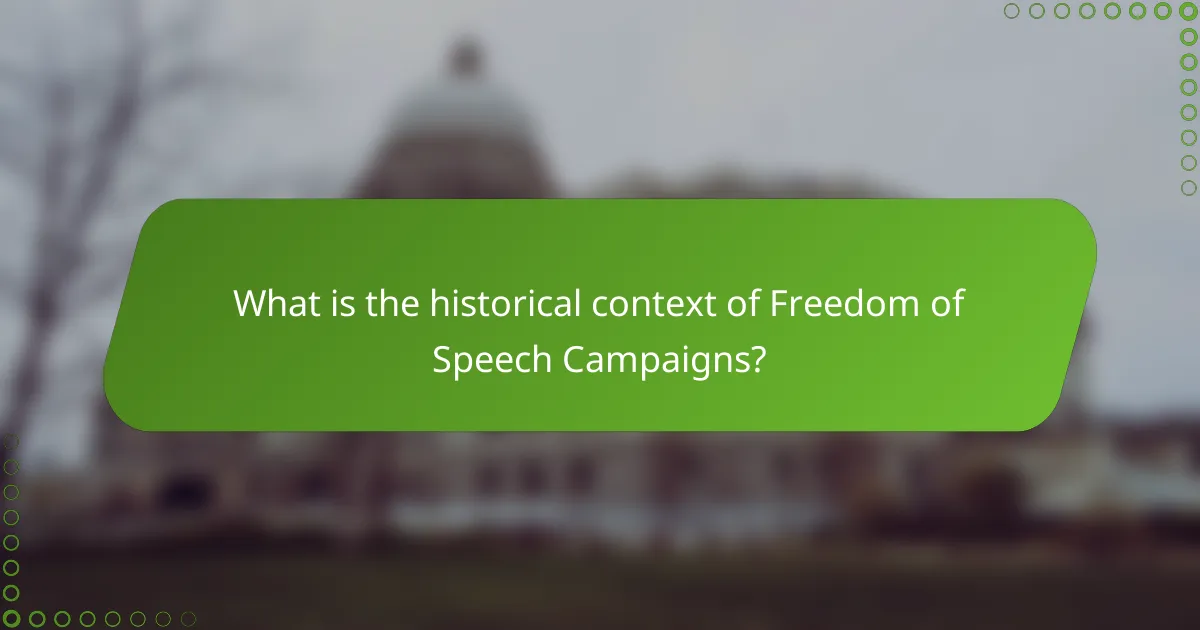
What is the historical context of Freedom of Speech Campaigns?
Freedom of Speech Campaigns emerged in response to governmental and societal repression of individual expression. The historical context dates back to ancient civilizations, where speech was often restricted by monarchies and religious authorities. In the 17th century, Enlightenment thinkers like John Locke and Voltaire advocated for the right to free expression. The American and French Revolutions in the late 18th century further solidified these ideals, leading to constitutional protections for free speech. The First Amendment of the U.S. Constitution, ratified in 1791, explicitly prohibits Congress from restricting speech. Throughout the 20th century, various movements, including civil rights and anti-war campaigns, utilized freedom of speech as a fundamental tool for social change. Landmark Supreme Court cases, such as Schenck v. United States (1919), shaped the legal understanding of free speech. These historical developments illustrate the ongoing struggle for and evolution of free speech rights across different societies.
How have historical movements shaped current Freedom of Speech Campaigns?
Historical movements have significantly influenced current Freedom of Speech campaigns. The civil rights movement in the 1960s emphasized the importance of free expression for marginalized communities. Activists fought against censorship and advocated for equal rights, shaping public discourse. The anti-war movement during the Vietnam War era highlighted the necessity of free speech in political dissent. This led to legal reforms protecting protest rights. Additionally, the feminist movement has expanded the conversation around speech to include issues of harassment and discrimination. These historical contexts have laid the groundwork for contemporary campaigns, which continue to address free speech in diverse social issues. The legacy of these movements is evident in ongoing debates about the balance between free expression and societal harm.
What notable figures have influenced the evolution of freedom of speech?
John Milton influenced freedom of speech with his work “Areopagitica” in 1644. He argued against censorship and for the importance of free expression. Voltaire, an Enlightenment thinker, championed civil liberties and famously stated, “I disapprove of what you say, but I will defend to the death your right to say it.” Thomas Jefferson emphasized the necessity of free speech for democracy in the United States. He believed that freedom of expression was essential for a functioning republic. In the 20th century, figures like George Orwell highlighted the dangers of totalitarianism, advocating for the protection of free speech. Martin Luther King Jr. used his voice to fight for civil rights, emphasizing the importance of free speech in social justice movements. These figures collectively shaped the understanding and evolution of freedom of speech through their writings and actions.
How have landmark cases defined freedom of speech rights?
Landmark cases have significantly defined freedom of speech rights in the United States. The First Amendment guarantees this freedom, but its interpretation has evolved through key judicial rulings. For example, in 1919, Schenck v. United States established the “clear and present danger” test. This case determined that speech could be limited if it posed a significant threat to national security.
In 1969, Tinker v. Des Moines Independent Community School District expanded student speech rights. The ruling stated that students do not lose their constitutional rights at school. Another pivotal case, New York Times Co. v. Sullivan in 1964, set a high standard for public figures to prove libel. This case protected press freedom and allowed for robust public discourse.
In 1971, the Pentagon Papers case, New York Times Co. v. United States, reinforced the principle against prior restraint. The Supreme Court ruled that the government could not prevent publication without compelling justification. These cases collectively shaped the legal landscape of free speech, balancing individual rights with societal interests.
What lessons can be learned from past Freedom of Speech Campaigns?
Past Freedom of Speech Campaigns teach several important lessons. Firstly, the necessity of clear legal frameworks is evident. Campaigns often succeed when supported by robust legal protections. For example, the Civil Rights Movement highlighted the need for laws safeguarding speech against government suppression.
Secondly, public engagement is crucial. Campaigns that mobilize community support tend to have a greater impact. The Anti-Vietnam War protests showed how collective action can influence public opinion and policy.
Additionally, the role of media is significant. Effective use of media amplifies messages and reaches wider audiences. The Arab Spring demonstrated how social media can facilitate grassroots movements.
Finally, the importance of adaptability is clear. Campaigns must evolve in response to changing political landscapes. The ongoing fight for digital rights reflects the need to address new challenges in free speech.
What strategies were effective in historical campaigns?
Effective strategies in historical campaigns for freedom of speech included grassroots mobilization, legal challenges, and public awareness initiatives. Grassroots mobilization involved rallying community support to amplify voices. Legal challenges often targeted restrictive laws, seeking judicial review to protect speech rights. Public awareness initiatives utilized media to inform citizens about free speech issues. For example, the ACLU’s defense of free speech cases in the 20th century highlighted the importance of legal advocacy. Additionally, organizations like PEN America used literature to raise awareness and promote dialogue on free expression. These strategies collectively contributed to significant legal and social advancements in freedom of speech.
How did public perception of freedom of speech change over time?
Public perception of freedom of speech has evolved significantly over time. Initially, in ancient societies, speech was often restricted by rulers to maintain control. The Enlightenment period marked a shift, with philosophers like Voltaire advocating for free expression. In the 20th century, global conflicts highlighted the importance of free speech as a fundamental human right. Landmark cases, such as the U.S. Supreme Court’s ruling in 1964 on New York Times Co. v. Sullivan, reinforced protections for speech against government censorship. Today, public perception is increasingly influenced by digital communication and social media, leading to debates over hate speech and misinformation. This ongoing evolution reflects changing societal values and technological advancements.
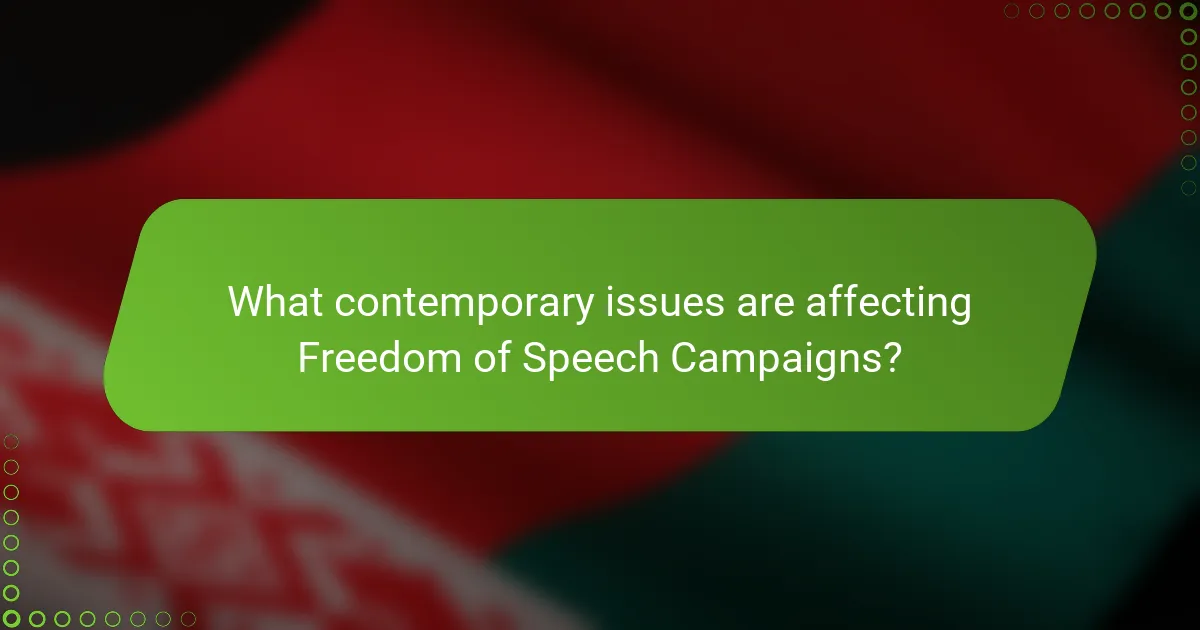
What contemporary issues are affecting Freedom of Speech Campaigns?
Contemporary issues affecting Freedom of Speech Campaigns include misinformation, censorship, and hate speech regulations. Misinformation undermines public discourse and challenges the integrity of information. Censorship by governments and tech platforms restricts voices and limits access to diverse viewpoints. Hate speech regulations aim to balance free expression with the protection of marginalized groups. These regulations can lead to debates over what constitutes hate speech. The rise of social media complicates enforcement and accountability. Additionally, political polarization intensifies conflicts over speech rights. These issues create a dynamic landscape for Freedom of Speech Campaigns.
How does misinformation challenge Freedom of Speech Campaigns?
Misinformation undermines Freedom of Speech Campaigns by creating confusion and distrust. It distorts public perception of facts, making it difficult for individuals to discern truth from falsehood. This distortion can lead to the silencing of legitimate voices. When misinformation spreads, it often triggers censorship efforts aimed at controlling harmful content. Such censorship can inadvertently restrict free expression and open dialogue. Research shows that misinformation campaigns can influence public opinion and policy decisions. For instance, a 2020 study by the Pew Research Center found that 64% of Americans believe misinformation has caused confusion about important issues. This confusion can stifle the very discussions that Freedom of Speech Campaigns aim to promote.
What are the implications of censorship in modern media?
Censorship in modern media restricts access to information and limits free expression. It can lead to a homogenization of viewpoints, stifling diversity in public discourse. Governments and corporations often impose censorship to control narratives and maintain power. This can undermine democratic processes by preventing informed citizen participation. Studies show that censorship correlates with increased public distrust in media sources. Research indicates that countries with strict media censorship have lower levels of press freedom and civil liberties. For example, the 2021 World Press Freedom Index ranked countries like North Korea and China at the bottom due to severe censorship practices. These implications highlight the critical need for protecting freedom of speech in media.
How do societal divisions impact the effectiveness of Freedom of Speech Campaigns?
Societal divisions significantly hinder the effectiveness of Freedom of Speech campaigns. These divisions often manifest as political, racial, or socioeconomic disparities. When communities are polarized, messages from Freedom of Speech campaigns may not resonate equally. For instance, campaigns may be perceived as biased or irrelevant by certain groups. This perception can lead to resistance or backlash against the campaign’s objectives. Research shows that when individuals feel marginalized, they are less likely to engage with or support initiatives promoting free speech. Additionally, societal divisions can create echo chambers, where individuals only hear affirming viewpoints. This isolation diminishes the potential for constructive dialogue and understanding. Overall, societal divisions create barriers that limit the reach and impact of Freedom of Speech campaigns.
What future trends may shape Freedom of Speech Campaigns?
Future trends that may shape Freedom of Speech Campaigns include the rise of digital platforms and social media. These platforms have transformed how information is disseminated and consumed. Increased reliance on technology may lead to new regulations on speech online. Governments may impose stricter laws to combat misinformation. Additionally, public awareness of free speech issues is growing. This awareness can lead to more grassroots movements advocating for change. Legal battles over censorship and hate speech are likely to increase. The global nature of the internet complicates jurisdictional issues. Overall, these trends indicate a dynamic future for Freedom of Speech Campaigns.
How might technology influence the landscape of freedom of speech?
Technology significantly influences the landscape of freedom of speech by enabling broader access to information and communication. Social media platforms facilitate the rapid dissemination of ideas and opinions. This democratization of speech allows marginalized voices to be heard. However, technology also presents challenges, such as misinformation and hate speech. Algorithms can amplify harmful content, impacting public discourse. Additionally, governments may use technology for surveillance and censorship. For example, countries like China employ advanced technologies to monitor and restrict online speech. The dual nature of technology creates both opportunities and threats to freedom of speech.
What emerging movements are advocating for freedom of speech rights?
Emerging movements advocating for freedom of speech rights include the Digital Rights Movement and the Free Speech Movement. The Digital Rights Movement focuses on protecting online expression and privacy. It addresses issues like censorship and surveillance on social media platforms. The Free Speech Movement, originating in the 1960s, has evolved to include contemporary issues such as campus speech rights. Both movements emphasize the importance of open dialogue in democratic societies. They seek to challenge laws and practices that restrict speech. Advocacy organizations like the Electronic Frontier Foundation support these movements. These organizations provide legal assistance and raise awareness about free speech issues.
What practical steps can individuals take to support Freedom of Speech Campaigns?
Individuals can support Freedom of Speech Campaigns by actively participating in advocacy efforts. They can join organizations that promote free speech rights, such as the American Civil Liberties Union (ACLU). Engaging in community discussions about free speech issues raises awareness and fosters dialogue. Writing letters to local representatives can influence policy decisions related to speech rights. Sharing informative content on social media amplifies the message of freedom of speech. Attending rallies and events dedicated to free speech demonstrates public support. Volunteering time or resources to relevant campaigns can provide practical assistance. Supporting media outlets that prioritize free speech helps sustain diverse viewpoints. These actions collectively contribute to the broader movement for protecting freedom of speech.
How can individuals effectively advocate for freedom of speech in their communities?
Individuals can effectively advocate for freedom of speech in their communities by raising awareness and engaging in dialogue. They should organize community events to discuss the importance of free expression. Hosting workshops can educate others about their rights and responsibilities regarding speech. Collaborating with local organizations amplifies their message and reach. Utilizing social media platforms enables wider dissemination of information and mobilizes support. Writing articles or opinion pieces in local publications can influence public opinion. Participating in town hall meetings allows individuals to voice their concerns directly to decision-makers. Supporting legislation that protects free speech rights reinforces their advocacy efforts.
What resources are available for those interested in promoting freedom of speech?
Organizations such as the American Civil Liberties Union (ACLU) provide resources for promoting freedom of speech. The ACLU offers legal assistance, educational materials, and advocacy tools. The Electronic Frontier Foundation (EFF) also supports free speech through digital rights protection. They provide guides on privacy and free expression online. Additionally, the Freedom Forum Institute offers research and training on First Amendment rights. Their resources include articles, reports, and educational programs. The National Coalition Against Censorship (NCAC) promotes free expression in schools and communities. They provide toolkits and support for combating censorship. These organizations collectively enhance understanding and advocacy for freedom of speech.
Freedom of Speech Campaigns are organized efforts aimed at promoting and protecting the right to express opinions without censorship. This article explores the legal frameworks, historical context, and contemporary issues surrounding these campaigns, highlighting their influence on society and the challenges they face today. Key topics include the impact of cultural contexts on free speech, notable historical events that sparked these movements, and the role of technology and social media in shaping current discourse. Additionally, the article addresses emerging trends, practical steps individuals can take to support free speech, and the resources available for advocacy.
